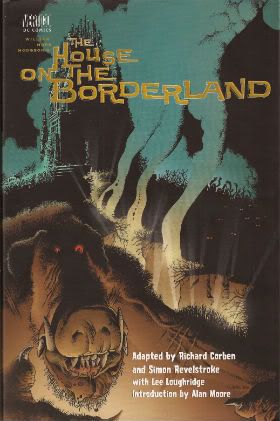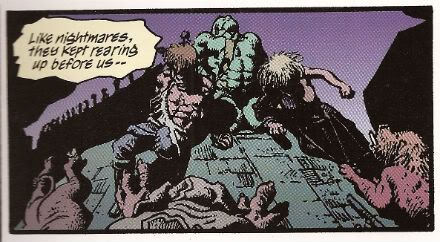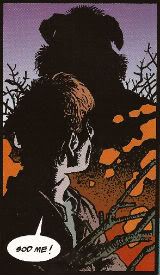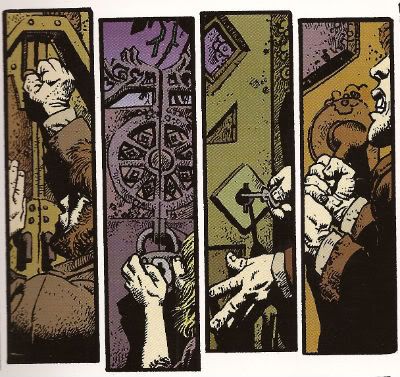"Like Porcelain, They Shattered." Comics! Sometimes They Contain Ageless Horror!
/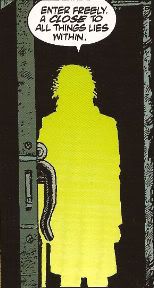 An eerie sense of deja vu descends upon you now as I talk about Richard Corben, Simon Revelstroke and a very odd house indeed. Viewings by appointment only, please call first to avoid disappointment!
An eerie sense of deja vu descends upon you now as I talk about Richard Corben, Simon Revelstroke and a very odd house indeed. Viewings by appointment only, please call first to avoid disappointment!
THE HOUSE ON THE BORDERLAND Adapted by Richard Corben and Simon Revelstroke Art by Richard Corben Words by Simon Revelstroke Coloured & separated by Lee Loughridge Lettered by Clem Robbins Introduction by Alan Moore Based on the book THE HOUSE ON THE BORDERLAND by William Hope Hodgson (Vertigo/DC Comics, H/B, Colour, $29.95 (2000))
Corben and Revelstroke’s 2000 adaptation of Hodgson’s 1908 novel is fronted by a lucid and informative introduction by one Alan Moore. Moore, not for the last time, reveals he has in fact not read the work (the adaptation rather than the novel, which he has read) in its entirety but assures his notional reader that it is no doubt of merit because Richard Corben is involved. No, this would not be the last time Moore would pass judgement on work he had not read but since his verdict here is positive and concerns the adaptation of a dusty old tome by an exponent of Comix it appears to have passed unnoticed and failed to ignite a conflagration of unfortunate dimensions.
Today such terms as “a conflagration of unfortunate dimensions” are applied to a bunch of people being vocal about their hurt feelings concerning what an exasperated old man whose opinion they don’t value thinks about some comics written by people who are a bit touchy and which involve characters shooting lasers from their eyes and flying about a bit. A scant few decades earlier such a description would have been applied to something like World War 1 (1914-1918). Now, the novel clearly precedes The Great War but Moore suggests it could reasonably be placed in the literary genre of ‘Invasion Literature’. Basically this is a series of novels/short stories produced independently by various and diverse authors such as H.G. Wells and John Buchan which seem to prefigure the horrendous event with their imaginative toying with the anxieties of society. I don’t recall if anyone ever actually claimed credit for predicting the apocaluptically sorry mess; it seems a little unlikely since people had some measure of self respect and would have drawn the line at enhancing their own reputations at the expense of an entire generation turned to bone meal. And Mark Millar hadn't been born then. Moore’s suggestion is novel since THOTB is initially a far less obvious candidate for inclusion in Invasion Literature than something like The War of The Worlds. Because THOTB is a far more chimerical beast indeed.
Moore’s claim is sound though as of the 85 pages which make up this adaptation fully 26 are concerned with the defense of the titular house from wave upon wave of animalistic invaders. It’s a relentless and exhausting read as the two humans, and Pepper the dog!, are driven further and further back; first into the house then to the very roof of the structure where the tide of mutant mis-shapes ceases finally but the horrors merely burrow deeper and attack more subtly. From hereonin the battle becomes apparently one between the narrator and the house itself characterised by sly suggestions and dark discoveries. The darkest of these is perhaps that the battle is intended not to destroy the narrator but to sway him to the house’s true purpose. For is it not called The House on the Borderland? Through the destruction of the narrator the intention seems to be to rebirth him as the master of the house, to accord him the function of guardian of The Borderlands. While defeat will entail his destruction the narrator’s victory can only ensure an eternal struggle to avoid a more encompassing and apocalyptic defeat.
But The Borderlands of what? The simple answer would be between sanity and insanity and, yes, that reading is here too. The narrator and his sister are initially presented as the ossified and reserved pair of any fiction which involves the wearing of top hats and frock coats on a daily basis. Soon though they are torn and dishevelled by their strenuous fight against “The Other” but once the physical forces recede the supernatural forces swell. Emotions become unseemly and desires best beaten with a stick become…apparent. Things fall apart. The narrator descends to the bowels of the house and becomes untethered from time (from reality?). Reality can no longer be trusted, surety is cast aside and as all times become one and the Black Sun (Black Hole?) with its boundless hunger can only be delayed not destroyed.
It’s pretty phantasmagorical stuff at once inviting and repelling comprehension. Aside from the inherent humour in Corben’s exaggerated stylings the adaptors play the whole thing straight. A prologue and epilogue are added to brace the main narrative with at least some form of closure without eroding any of the themes or atmosphere but the meat of the matter is as ever in the adaptation itself. While Corben is the star and the draw here Revelstroke does a nice job that shouldn't go unacknowledged. Confined largely to captions taken from the narrator’s recollections he (and Corben: synergy!) do a grand job of yoking them to images to their best effect. Sometimes the image will belie the caption, sometimes the caption will purposefully be woefully inadequate at describing the illustrated horrors and at times the horrors will be so overwhelming the caption is dropped entirely. Corben and Revelstroke understand about words and pictures and here they subdue their creative egos to the end of creating a satisfactory work. It would be easy to dismiss the writing as it never flails for your attention as though the writer were desperately elbowing the artist out of the way for the crumbs of your attention. Easy but wrong. Often the taut restraint pays off beautifully and I’ll try and demonstrate that now with my favourite bit. Here is something that would appear in the original novel upon the printed page without visual reinforcement:
”The shadows lapped at her. Firelight struck glints off the droplets upon her breasts…Her grunted words were unintelligible. Her need was…apparent!”
Nice stuff, particularly as you know, if you read it in context, that “she” is his sister. Such interactions between siblings, at least in England, are generally regarded as being wrong. Not even if she has an anachronistically denuded pudenda. So, nice, yes, but not as nice as:
Isn’t that jolly super! I thus trust Simon Revelstroke’s talent is…apparent!
And Corben? Alan Moore says in his introduction, “Mr. Richard Corben, in his finest visionary form, a genuine giant of his chosen medium.” And he ain't pissing up a rope there, kids! To adapt something as well-regarded as THOTB the comic has to bring something special. As good as Mr. Revelstroke is his words are no replacement for the Hope Hodgson's originals. But add them to the bloated beauty of Richard Corben and we've got something magical happening. While in RAGEMOOR Corben utilises a more traditional technique, one appropriate to the traditional genre trappings of his tale, in THOTB Corben embraces the swirling nuttiness of the on-page happenings to bust out some smooth moves visually. There’s plenty of variations on these pages in panel size, shape and position and they all have their part to play in the narrative structure Corben’s embedded them into. If there’s a page which consists solely of a grid then it’s a rarity and such a rarity that it doesn't spring to my mind. Corben’s varying variations keep the eye moving about and engaged.
There’s no extended stretch where the eye can become complacent. Even panels simply placed next to each other will be slightly larger or smaller than their neighbours. The mission here seems to be to keep the eye moving, keep the eye interested, keep that eye engaged, keep that eye on its toes. The contents of the panels are the usual Corben glories. Everything has that weirdly organic texture whether it be flesh, fauna, smoke or stone. And he does that thing with the angles. That thing where he draws a scene from an unfamiliar angle but also positions the elements in a fresh way usually with shadows employed to further occlude the meaning of the image; forcing you to halt your gaze and look at it until it reveals itself. It’s a great way to control the pace of the reader without having to use up real estate on splash pages. Embracing the lurid and fanciful shenanigans he’s asked to illustrate Corben’s pages are at times hypnotically arresting. The savage combat, the twisted landscapes, the mis-shapes and malformations and the whole bizarre and disconcerting deal play to Corben’s strengths. And yet the finest part of his work here, for me, is one of the more subdued scenes where the narrator has laid behind him a trail of candles which begin to go out one by one as the darkness, and whatever calls it home, relentlessly pursues him.
In the introduction Alan Moore also makes mention that he is pleased that the novel THOTB has escaped the attempted whitewashing of genre fiction from earlier centuries. Corben and Revelstroke’s adaptation should help entail the novel remains in the public imagination. Provided someone points out that said adaptation exists and that it is VERY GOOD! Of course it'd probably help if some other folks read it too.
And like all sense of sanity, decorum or restraint I am gone!
Hope you had a nice weekend and read some COMICS!!!


